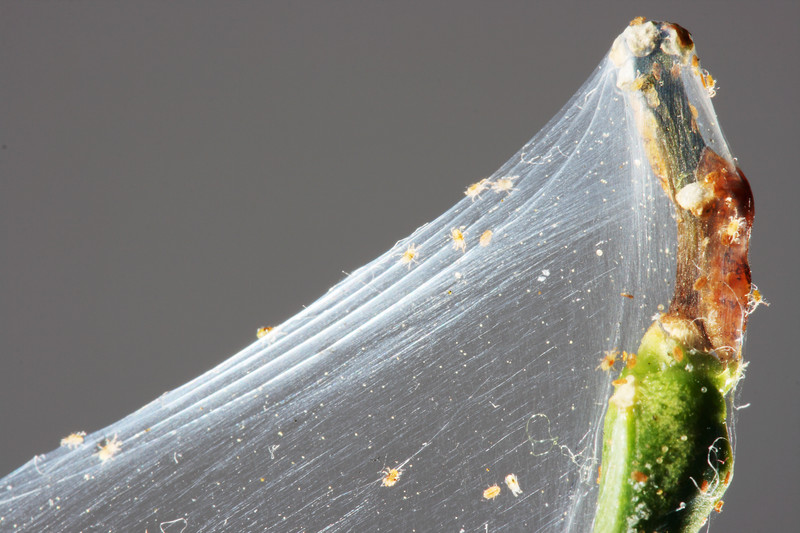Spider mites are nearly microscopic creatures about 1/50 inch long. They are reddish-brown or pale in color with eight legs, much like a spider.
The spider mite is not an insect; it is an arachnid, the class of invertebrate animals that includes spiders.
Good Products for Pest and Disease Control at Amazon:
- Garden Safe Snail and Slug Bait
- Bonide Sulfur Fungicide
- Monterey BT Caterpillar Killer
- Neem Bliss 100-% Cold Pressed Neem Oil
- Safer Brand Insect Killing Soap
- PyGanic Botanical Insecticide

Mites are the smallest creatures that you can actually see in the garden.
Mites feed on leaves, fruits, and roots. Most often, they feed on the undersides of leaves where they can spin protective silk webs. They feed by puncturing plant cells and sucking the juices. Their feeding will turn leaves silvery as the green tissue is sucked away. Severe spider mite damage can cause plants to die.
Spider mites live for two to four weeks. Adult female mites can lay 20 eggs each day through their adult lives. Eggs are laid at the base of plants or on leaves and buds and hatch in about three days. Young mites mature into adulthood in about five days and then live another one to three weeks.
Spider mites thrive in warm weather. A population of mites can explode when temperatures reach 80°F or 27 °C. When the weather turns chilly, adult mites hibernate in garden debris or tree bark. In warm regions, they may be active all year. Growth and egg-laying are sped up by warm weather. There are many generations in a year.
Spider mites can be found throughout North America, especially in arid climates.
Scientific name: Tetranychus urticae (twospotted spider mite); Class: Atachnida
Target plants
Spider mites feed on any vegetable crop and fruit trees. They can be serious pests for beans, squash, melons, eggplants, and tomatoes in hot, dry weather.
Feeding habits and damage
Spider mites bruise plant cells with their mouthparts. They often congregate on the undersides of leaves to feed. Leaves are left stippled, speckled, and silvery. Leaves often turn yellow from the damage. Spider mites often spin a fine web. Fruits attacked by spider mites will be russeted, dry, rough, and deformed. Some mites will leave blisters on leaves.
Organic controls
Spray cold water on leaves to kill mites or use insecticidal soap. Release predatory mites or encourage predatory mites by not using insecticides in the garden—including natural insecticides.
Organic control calendar
Here is what you can do seasonally to control spider mites:
- Before planting: Avoid fertilizers rich in nitrogen which pushes green plant growth; spider mites feast on green leaves.
- At planting time: Spray around planting beds with hot pepper or garlic spray to repel spider mites.
- While crops develop: Hit spider mites with a strong spray of water and wash them away; be sure to spray both sides of the leaves. Spraying plants with water decreases dry air around plants; mites thrive in hot, dry situations. Use insecticidal soap spray, neem, or sulfur dust to kill mites. Repeat sprays as needed. Note: sulfur and oil sprays can damage plants in warm and hot weather so apply with caution.
- After harvest: Clean the garden of plant debris and weeds in which mites can shelter or hibernate.
Natural predators
Insect predators include lacewings, lady beetles, and predatory mites (predatory mites have long legs and move more quickly than spider mites).
Related articles:
Vegetable Garden Organic Pest Control
Vegetable Garden Diseases Problem Solver
Vegetable Garden Organic Weed Control
Garden Planning Books at Amazon:
- Vegetable Garden Almanac & Planner
- Kitchen Garden Grower’s Guide Vegetable Encyclopedia
- Vegetable Garden Grower’s Guide
- Tomato Grower’s Answer Book















